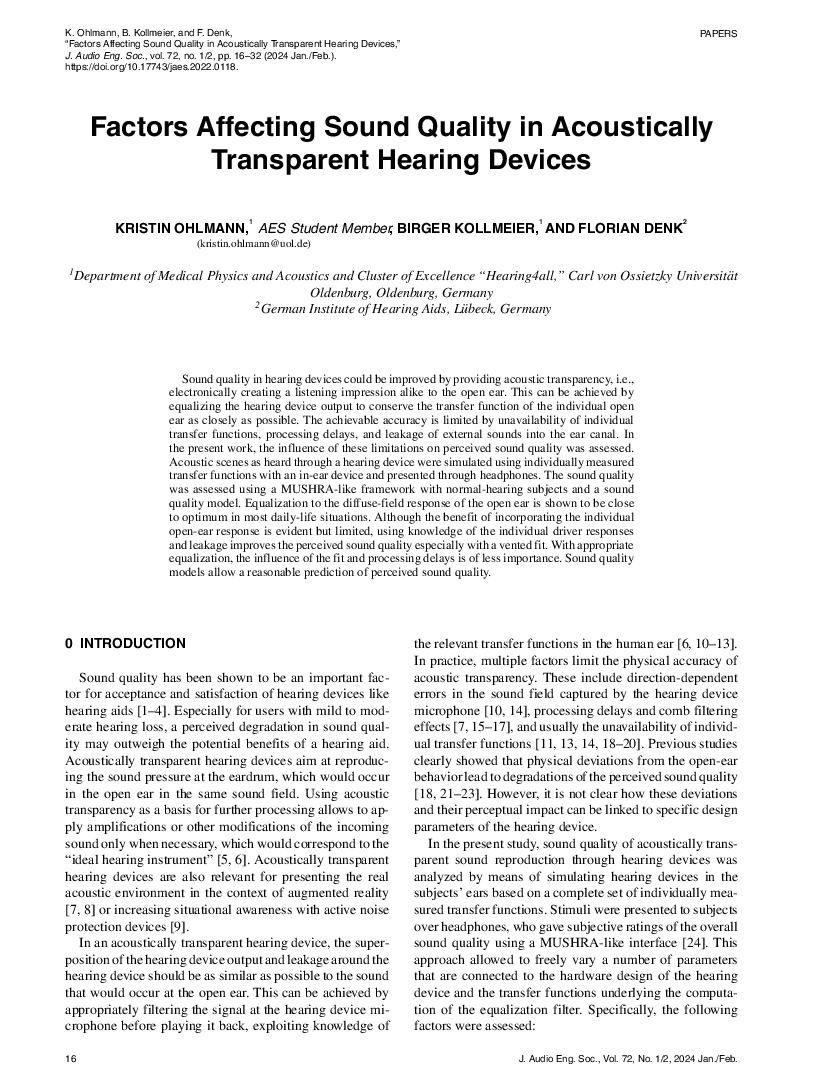Home / Publications / E-library page
You are currently logged in as an
Institutional Subscriber.
If you would like to logout,
please click on the button below.
Home / Publications / E-library page
Only AES members and Institutional Journal Subscribers can download
Sound quality in hearing devices could be improved by providing acoustic transparency, i.e., electronically creating a listening impression alike to the open ear. This can be achieved by equalizing the hearing device output to conserve the transfer function of the individual open ear as closely as possible. The achievable accuracy is limited by unavailability of individual transfer functions, processing delays, and leakage of external sounds into the ear canal. In the present work, the influence of these limitations on perceived sound quality was assessed. Acoustic scenes as heard through a hearing device were simulated using individually measured transfer functions with an in-ear device and presented through headphones. The sound quality was assessed using a MUSHRA-like framework with normal-hearing subjects and a sound quality model. Equalization to the diffuse-field response of the open ear is shown to be close to optimum in most daily-life situations. Although the benefit of incorporating the individual open-ear response is evident but limited, using knowledge of the individual driver responses and leakage improves the perceived sound quality especially with a vented fit.With appropriate equalization, the influence of the fit and processing delays is of less importance. Sound quality models allow a reasonable prediction of perceived sound quality.
Author (s): Ohlmann, Kristin; Kollmeier, Birger; Denk, Florian
Affiliation:
Department of Medical Physics and Acoustics and Cluster of Excellence “Hearing4all,” Carl von Ossietzky Universität Oldenburg, Oldenburg, Germany; Department of Medical Physics and Acoustics and Cluster of Excellence “Hearing4all,” Carl von Ossietzky Universität Oldenburg, Oldenburg, Germany; German Institute of Hearing Aids, Lübeck, Germany
(See document for exact affiliation information.)
Publication Date:
2024-01-06
Import into BibTeX
Permalink: https://aes2.org/publications/elibrary-page/?id=22375
(1063KB)
Click to purchase paper as a non-member or login as an AES member. If your company or school subscribes to the E-Library then switch to the institutional version. If you are not an AES member Join the AES. If you need to check your member status, login to the Member Portal.

Ohlmann, Kristin; Kollmeier, Birger; Denk, Florian; 2024; Factors Affecting Sound Quality in Acoustically Transparent Hearing Devices [PDF]; Department of Medical Physics and Acoustics and Cluster of Excellence “Hearing4all,” Carl von Ossietzky Universität Oldenburg, Oldenburg, Germany; Department of Medical Physics and Acoustics and Cluster of Excellence “Hearing4all,” Carl von Ossietzky Universität Oldenburg, Oldenburg, Germany; German Institute of Hearing Aids, Lübeck, Germany; Paper ; Available from: https://aes2.org/publications/elibrary-page/?id=22375
Ohlmann, Kristin; Kollmeier, Birger; Denk, Florian; Factors Affecting Sound Quality in Acoustically Transparent Hearing Devices [PDF]; Department of Medical Physics and Acoustics and Cluster of Excellence “Hearing4all,” Carl von Ossietzky Universität Oldenburg, Oldenburg, Germany; Department of Medical Physics and Acoustics and Cluster of Excellence “Hearing4all,” Carl von Ossietzky Universität Oldenburg, Oldenburg, Germany; German Institute of Hearing Aids, Lübeck, Germany; Paper ; 2024 Available: https://aes2.org/publications/elibrary-page/?id=22375
@article{ohlmann2024factors,
author={ohlmann kristin and kollmeier birger and denk florian},
journal={journal of the audio engineering society},
title={factors affecting sound quality in acoustically transparent hearing devices},
year={2024},
volume={72},
issue={1/2},
pages={16-32},
month={january},}